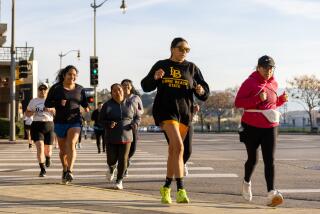On the Track, Speed Is Nice, but Stamina Is Essential
- Share via
She is pacing the sidelines near the starting line, shivering under an overcast sky. Her coach drapes an arm around her shoulder and leans in to whisper last-minute advice, steering her along the path her race will take.
Suddenly, the loudspeaker blares--”Last call, Girls’ 800”--and my daughter bolts for the starting line, jostling among a dozen other girls for space.
“As soon as you can,” her coach yells after her, “try to move to an inside lane. Then just stay with the pack. Don’t get left behind. You’ll be OK. Just don’t get left behind.”
Getting left behind is my daughter’s biggest fear. It is her first time on a track in four years; her first time ever running this race.
Eight hundred meters. Almost half a mile. Two laps around the track. It is four times longer than any race she’s ever run. A contest not just of speed, but of endurance, strength and strategy.
Her coaches aren’t expecting much. She is wearing my old running shoes. She has been training for less than a week.
But running is a metaphor for life, I tell her. Your shoes count less than your stamina. And you have been training for this for most of your life.
*
My daughters got their speed from their father. It was a gift he bequeathed them, like curly eyelashes and thick eyebrows. So I hauled them to the park the year he died, and signed them up for the local track squad. They were sent to run sprints, just like their dad.
They ran like the wind that first season, winning races at every meet. “Your daddy,” I told them, “would be so proud.” But by the second year, the bloom was off the rose. They hated all the hours of training; what a waste for a 30-second run. They began losing as often as they won.
So I let them quit, and tried to put aside my guilt; to shake the notion that I was, somehow, letting their father down. And it has taken me seven years to realize that I might not be raising sprinters, after all. Their speed may have been their father’s gift, but stamina could be mine.
I talked them back to the track this year, and pointed them away from spikes and blocks, toward events that require more than fast-twitch muscles and fleet-foot speed.
My bouncy, long-legged 10-year-old is trying the high jump this time around. She’s got “hops,” her coaches tell me. “All she needs now is technique.” Her 12-year-old sister is eyeing the hurdles, trying to master its mix of speed, strength and timing.
They will learn, if they haven’t already, that winning means more than breaking the tape. It means getting over barriers without losing your balance, learning to leap high and land softly, pressing on even if you’re behind in the race.
*
My teenager looks out of place at the starting line, one brown-skinned girl among a gaggle of blonds, shoving to stake out her space as the starter’s gun sounds.
But the moment she takes off, her awkwardness disappears. She looks like a gazelle as she runs, weaving her way from the back of the pack to the middle. “Try to stay with the group,” I whisper. “Don’t get left behind.”
The leader rounds a turn in the distance, far ahead of the other runners. Behind her, another girl emerges; then a third breaks free from the pack. And I realize that girl is my daughter, striding toward the half-way mark, her long legs locked on third place.
Near the finish line she begins to falter. Her legs are shaking, she is running out of breath. Behind her, the pack is closing in, picking up the pace. “Kick it, kick it!,” her teammates yell. And she kicks it, crossing the line in third place.
She stumbles off the track and into my arms. “I finished,” she marvels, her words coming out between jagged breaths, as she pounds her chest for air and doubles over in pain.
Her coach approaches, stunned by her time--20 seconds faster than her practice best. “What a run,” she says. “You can win this next time.”
Staying with the pack is no longer an option. And neither is being left behind.
More to Read
Go beyond the scoreboard
Get the latest on L.A.'s teams in the daily Sports Report newsletter.
You may occasionally receive promotional content from the Los Angeles Times.










